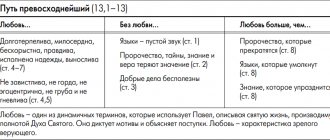order
The letters of Paul in the order in which they appear in the New Testament are:
| Name | Addressees | Greek | Latin | Abbreviations | ||
| Full | Min. | |||||
| Romans | Church in Rome | Πρὸς Ῥωμαίους | Epistola ad Romanos | ROM | Ro | |
| First Corinthians | Church in Corinth | Πρὸς Κορινθίους Αʹ | Epistola I in Corinthia | 1 Cor. | 1C | |
| Second Corinthians | Church in Corinth | Πρὸς Κορινθίους Βʹ | Epistole II ad Corinthios | 2 Cor. | 2C | |
| Galatians | Church in Galatia | Πρὸς Γαλάτας | Epistola ad Galatas | Gal | gram | |
| Ephesians | Church in Ephesus | Πρὸς Ἐφεσίους | Epistola ad Ephesios | Eph | E | |
| Philippians | Church in Philippi | Πρὸς Φιλιππησίους | Epistola ad Philippenses | Phil | Fi | |
| Colossians | Church in Colossae | Πρὸς Κολοσσαεῖς | Epistola ad Colossenses | Col | C | |
| The first Thessalonians | Church in Thessaloniki | Πρὸς Θεσσαλονικεῖς Αʹ | Epistola I in Thessaloniki | 1 Thess | 1h | |
| Second Thessalonians | Church in Thessaloniki | Πρὸς Θεσσαλονικεῖς Βʹ | Epistole II to the Thessalonians | 2 Thess | 2h | |
| First Timothy | Saint Timothy | Πρὸς Τιμόθεον Αʹ | Epistola I and Timoteum | 1 Tim | 1T | |
| Second Timothy | Saint Timothy | Πρὸς Τιμόθεον Βʹ | Epistole II ad Timotheum | 2 Tim | 2T | |
| Titus | Saint Titus | Πρὸς Τίτον | Epistola ad Titum | Tit | T | |
| Philemon | Saint Philemon | Πρὸς Φιλήμονα | Epistola ad Philemonem | Filim | P | |
| Hebrews * | Jewish Christians | Πρὸς Έβραίους | Epistola ad Hebraeus | EUR | HOUR | |
This order is remarkably consistent in the manuscript tradition, with very little variation. The obvious principle of organization is to reduce the length of the Greek text but retain the four Pastoral Epistles addressed to individuals in a separate final section. The only anomaly is that Galatians precedes the slightly longer book of Ephesians.[5]
In modern editions, the formally anonymous Epistle to the Hebrews is placed at the end of Paul's letters and before the General Epistles. This practice was popularized in the 4th century. Vulgate to Jerome, who knew ancient doubts regarding its authorship, as well as most medieval Byzantine manuscripts without exception.[5]
The placement of Hebrews among Paul's epistles is less consistent in the manuscripts:
- between Romans and 1 Corinthians (that is, in order of length, without dividing Corinthians): Papyrus 46 and minor 103, 455, 1961, 1964, 1977, 1994.
- between 2 Corinthians and Galatians: minuscules 1930, 1978 and 2248.
- between Galatians and Ephesians: implied by the numbering in . However, B ends with Galatians, and Ephesians begins on the same side of the same page (p. 1493); likewise 2 Thessalonians ends and Hebrews begins on the same side of the same sheet (p. 1512).[6]
- between 2 Thessalonians and 1 Timothy (that is, before the pastorals): , , , , HOUR, , , 0150, 0151 and about 60 minuscules (e.g. 218, 632)
- after Philemon: , 048, , , and most of the tiny ones.
- omitted: and gram
About the works of the church fathers
- Tertullian, Eusebius of Caesarea, Jerome, Origen and Augustine -
these authors and their works were invented by Latin medieval monks.
- The works of Eusebius11 were written in Latin by medieval monks in Paris. They were then translated into Greek to show that the early churches were formed in Greece.
- "Jerome" and "Augustine" are not the names of people who wrote more than 1,400 years ago, but a pseudonym for a monastic faction of the Renaissance.
- Origen coined the term "God-man".
- Monks created the doctrine of original sin (Romans 5:12).
- In dogmatic and polemical works, Tertullian mentions only 1 and 2 letters to Timothy, Gallatians, Romans, 1 and 2 Corinthians, Philippians.
- The legend of Marcion's works appears relatively late, and is placed under the title "Tertullian".
- Tertullian first formulated the concept of the Trinity and laid the foundation for ecclesiastical Latin12.
Authenticity
Agreed dates of Paul's letters
Captivity letters (disputed) in orange Pastoral letters (pseudepigraphic) in red
| 36 | (31–36 CE: conversion of Paul) |
| 37 | |
| 38 | |
| 39 | |
| 40 | |
| 41 | |
| 42 | |
| 43 | |
| 44 | |
| 45 | |
| 46 | |
| 47 | |
| 48 | |
| 49 | |
| 50 | First Epistle to the Thessalonians |
| 51 | Second Epistle to the Thessalonians |
| 52 | |
| 53 | Epistle to the Galatians |
| 54 | First Epistle to the Corinthians |
| 55 | Epistle to the Philippians |
| Epistle to Philemon | |
| 56 | Second Epistle to the Corinthians |
| 57 | Epistle to the Romans |
| 58 | |
| 59 | |
| 60 | |
| 61 | |
| 62 | Epistle to the Colossians |
| Epistle to the Ephesians | |
| 63 | |
| 64 | First Epistle to Timothy |
| Second Epistle to Timothy | |
| Epistle to Titus | |
| 65 | |
| 66 | |
| 67 | (64–67 CE: death of Paul) |
Main articles: Authorship of the Epistles of Paul and Pseudepigrapha
In all of these epistles, except Hebrews, the author and writer claims to be Paul. However, the disputed letters may have been written using the name Paul, since at that point in history it was common to attribute that name.[7]
The seven letters (with agreed dates)[8] are considered genuine by most scholars:
- First Thessalonians (c. 50 AD)
- Galatians (c. 53)
- First Corinthians (c. 53–54)
- Philippians (c. 55)
- Philemon (about 55)
- Second Corinthians (c. 55–56)
- Romans (c. 57)
Letters by which scholars are roughly evenly divided:[2]
- Colossians (c. 62)
- Second Thessalonians (c. 49–51)
The letters were considered pseudepigraphic by many scholars (traditional datings are given):[2]
- Ephesians (c. 62)
- First Timothy (c. 62–64)
- Second Timothy (c. 62–64)
- Titus (c. 62–64)
In conclusion, Hebrews, although anonymous and not in letter form, has long been included in the collection of Paul's letters. Although some churches attribute Epistle to the Hebrews to Paul,[9] neither most Christianity nor modern scholars do so.[2][10]
Influence
Paul of Tarsus was first and foremost an apostle, missionary and preacher. He addressed his letters to different communities and people with the intention of realizing his goal of building the Church, and he used the epistolary genre as a means to disseminate his knowledge of the Christian message and, above all, to apply it to specific problems. that arose in areas that were not possible to visit in person. These questions often served as the starting point for a broader and more meaningful discussion of the basic truths of Christian faith and behavior. [ 25 ] However, Paul's letters survived far beyond the occasion for which they were written, and made their author one of the most influential figures in the history of Christendom. [26][27]
Collection of messages
The first collection of Paul's letters is believed to be by Marcion of Sinope in the early 2nd century,[13] although it is possible that Paul first collected his letters for publication himself.[14] In Paul's day, letter writers typically kept one copy for themselves and sent a second copy to the recipient(s); surviving collections of ancient letters sometimes came from senders' copies and sometimes from recipients' copies.[15] The collection of Paul's letters circulated separately from other early Christian writings and later became part of the New Testament. Once the canon was established, the Gospels and Pauline letters formed the basis of what would become the New Testament.[16]
Financial horoscope
The beginning of the year will not be easy financially for many zodiac signs - the change of elements will be accompanied by various kinds of crises in areas of life related to material wealth. Good luck will favor those who at this time can unite with like-minded people and find a common language with competitors.
Do not waste money in the year of the Tiger, especially do not spend money on luxury goods and excessive entertainment. Budget stability, investments in the future and competent financial planning - this is what the manager of the year will appreciate.
The year 2022 of the Water Tiger is not very suitable for monotonous, painstaking and monotonous work. If your field of employment can be described in these words, then you probably want to change your occupation.
In addition, 2022 is a great time for self-development and education. This can serve as an impetus to change your current activity to a more comfortable and profitable one.
Jupiter, the planet of “Great Happiness,” will spend the first half of the year in the constellation Pisces. This position of the planet will bring material success to the signs of the element of water - Pisces themselves, as well as Cancers and Scorpios. In the second half of the year, after Jupiter moves into the fiery sign of Aries, luck awaits those born under the signs of Sagittarius, Leo and Aries.
The Year of the Tiger will be quite active for many zodiac signs and it is likely that some will find it difficult to maintain the fast pace. In 2022, you should definitely find time to relax and pay attention to a healthy lifestyle. This is also a great time to start breaking your bad habits.
Recommendations
- New Jerome's Bible Commentary
, publ. Geoffrey Chapman, 1989, chapter 60, page 920, color. 2 “That Paul is neither directly nor indirectly the author is now the view of almost all scholars without exception. For details see Kümmel, I [introduction to] N[ew]T [estament, Nashville, 1975] 392–94, 401–03" - ^ a b c d e
Structure of New Testament Writing, from Catholic Resources Author: Felix Just, S.J. - Richards, E. Randolph. Paul and First Century Letter Writing: Secretaries, Composition, and Assembly
.
Downers Grove, Illinois; Leicester, England: InterVarsity Press; Apollos, 2004.[ page needed
] - Metzger, Bruce M. (1987). The Canon of the New Testament: Its Origin, Development, and Significance
(PDF). pp. 295–96. ISBN 0198261802. Archived from the original (PDF) on 06/01/2013.CS1 maint: ref = harv (link to site) - ^ a b
Trobisch, David (1994).
The Collected Letters of Paul: In Search of the Origins
. pp.1–27. ISBN 0800625978 .CS1 maint: ref = harv (link to website) - Vatican Digital Library (DigiVatLib), Manuscript - Vat.gr.1209
- Joseph Barber Lightfoot, in his Commentary on Galatians,
writes: “For the present time [Gal.
6:11] the apostle takes his pen from the amanuensis, and the concluding paragraph is written in his own hand. Ever since letters began to be forged in his name (2 Thess. 2:2; 3:17), it seems to have been his practice to end with a few words in his own handwriting, as a precaution against such forgeries... In this case he writes an entire paragraph briefly and eagerly summarizing the main lessons of the message. , incoherent sentences. He also writes in large bold letters (Greek pelicoi gramsin
) that his handwriting can reflect the energy and determination of his soul.” - Robert Wall, The New Interpreter's Bible, vol.
X (Abingdon Press, 2002), p. 373. - Arkhipov, Sergei, ed. (1996). Apostle
. New Canaan, PA: St. Tikhon's Seminary Press. p. 408. ISBN 1-878997-49-1. - Ellingworth, Paul (1993). Commentary on the New International Greek Testament: The Epistle to the Hebrews
. Grand Rapids, MI: Wm. B. Eardmans Publishing Co. S. 3. - Also called Paul's Previous Epistle to the Corinthians
"Archive Copy."
Archived from the original on 2006-06-23. Retrieved 2006-06-29.CS1 maint: archived copy as title (site link) or Previous Corinthian letter of Paul
.[1], possibly Third Corinthians - "Apologetics Press - Are There Lost Books of the Bible?" apologeticspress.org
. - Price, Robert M. "The Evolution of the Pauline Canon." Journal of Higher Criticism
. Drew University Institute for Advanced Critical Studies. Retrieved February 13, 2022. But the first collector of Paul's letters was Marcion. - Trobisch, David (2001). Collection of Paul's letters
.
Bolivar, MO: Still Waters. ISBN 978-0966396676. His thesis is that Paul himself collected and edited some of his letters. (From the foreword by Gerd Theissen, University of Heidelberg)[ page needed
] - Rees, Steve. Paul's Great Letters: Paul's Subscriptions in the Light of Ancient Epistolary Conventions.
London: T&T Clark, 2016.[
page needed
] - Trobisch2001
About the history of Christianity
- The imaginary Tertullian7 compiled the entire history of Christianity and disseminated it throughout the world. This could not have happened earlier than the middle of the 16th century.
- History, between the 7th and 14th centuries, was invented by monastic writers who created imaginary characters and events.
- Concepts such as “Church Fathers”, “Gospels”, “Saint Apostle Paul” are absent in early Christian texts.
- There are no surviving manuscripts about the history of the church before the beginning of the 16th century.
- Literary monks developed alphabets, parchments, and inks to represent manuscripts of various ages.
- The adoption of the Creed at Nicaea is a fiction.
- Latin was the original language of the church. For example, Virgil Polydorus8 used the works of only Latin authors, without reference to Greek authors, which means that Latin was the original language of the church.
- The Catholic Church was established relatively recently during the Council of Trent,9 or at the time when the decrees were drawn up, and these decrees, for the most part, formally based on the doctrine of Paul, are in reality the expression of the opinion of the fathers (monks) who "made" Paul.
Here are brief excerpts from the proposals offered on behalf of Paul:
“Heavenly Father, the Father of mercies and God of all comfort, sent His Son Christ. The coming of Jesus was predicted back in the Old Testament. He can free the Jews who lived according to the law and the Gentiles who followed Him and all can become sons of God. Christ atoned before God through faith and his blood for our sins, but not only ours, but also the sins of the whole world.”
Bibliographic resources
- Aland Kurt. "The problem of anonymity and pseudonymity in Christian literature of the first two centuries." Journal of Theological Studies
12 (1961): 39–49. - Bahr, Gordon J. "Paul and Letter Writing in the First Century." Catholic Biblical Quarterly
28 (1966): 465–77.
idem, “Subscriptions in the Letters of Paul.” Journal of Biblical Literature
2 (1968): 27–41. - Bauckham, Richard J. "Pseudo-Apostolic Letters." Journal of Biblical Literature
107 (1988): 469–94. - Carson, D.A. "Pseudonymity and pseudepigraphy." Dictionary of the New Testament
. Ed. Craig A. Evans and Stanley E. Porter. Downers Grove: InterVarsity, 2000. 857–64. - Cousar, Charles B. Letters of Paul
. Interpretation of biblical texts. Nashville: Abingdon, 1996. - Deissmann, G. Adolf. Biblical Studies
. Per. Alexander Griv. 1901. Peabody: Hendrickson, 1988. - Doty, William G. Letters in Primitive Christianity
. Guides to Bible Scholarship. New Testament. Ed. Dan O. Via Jr. Philadelphia: Fortress, 1988. - Gamble, Harry Y. "Amanuensis." Anchor Bible Dictionary
. Vol. 1. Ed. David Noel Friedman. New York: Doubleday, 1992. - Haines-Eitzen, Kim. "'Girls Learning to Write Beautifully': Women Scribes in Roman Antiquity and Early Christianity." Journal of Early Christian Studies
6.4 (1998): 629–46. - Kim, Jung Seok. A Theological Introduction to the Epistles of Paul
. Eugene, OR: Cascade Books, 2011. - Longenecker, Richard N. "Ancient Amanuens and the Epistles of Paul." New Dimensions in New Testament Study
.
Ed. Richard N. Longenecker and Merrill K. Tenney. Grand Rapids: Zondervan, 1974. 281–97. idem, "On the Form, Function, and Authority of the Letters of the New Testament." Scripture and Truth
. Ed. YES. Carson and John D. Woodbridge. Grand Rapids: Zondervan, 1983. 101–14. - Murphy-O'Connor, Jerome. Pavel the Writer: his world, his opportunities, his skills
. Collegeville, MN: Liturgy, 1995. - Richards, E. Randolph. The Secretary in the Epistles of Paul
.
Tübingen: Mohr, 1991. idem, “The Codex and the Early Collection of Paul's Letters.” Research Bulletin
8 (1998): 151–66.
Come, Paul and Letter Writing in the First Century: Secretaries, Composition, and Assembly
. Downers Grove: InterVarsity, 2004. - Robson, E. Iliffe. "Composition and Dictation in the Books of the New Testament." Journal of Theological Studies
18 (1917): 288–301. - Stowers, Stanley K. Letter Writing in Greco-Roman Antiquity
. Library of Early Christianity. Vol. 8. Ed. Wayne A. Meeks. Philadelphia: Westminster, 1989. - Wall, Robert W. "Introduction to Epistolary Literature." The New Interpreter's Bible
. Vol. 10. Ed. Leander E. Keck. Nashville: Abingdon, 2002. 369–91. - Hart, David Bentley. "New Testament". New Haven and London: Yale University Press: 2022. 570–74.







